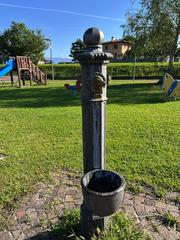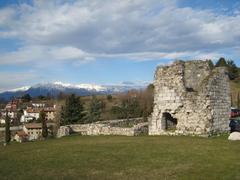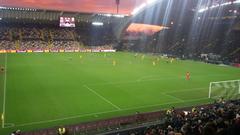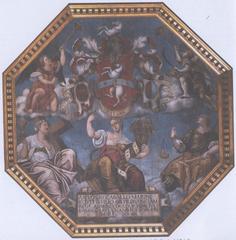University of Udine Visiting Hours, Tickets, and Historical Sites Guide
Date: 03/07/2025
Introduction to the University of Udine and Its Significance
Situated in the heart of Friuli Venezia Giulia in northeastern Italy, the University of Udine (Università degli Studi di Udine) stands as a symbol of regional resilience, cultural preservation, and educational innovation. Established in 1978 as a direct response to the 1976 Friuli earthquake, the university’s founding mission was to promote advanced education, foster research, and revitalize the community, while safeguarding the Friulian identity. Today, with nearly 15,000 students, the university is recognized for its interdisciplinary programs, especially in the humanities and cultural heritage, and its strong regional and international collaborations.
Its central location within Udine’s historic center offers visitors easy access to iconic landmarks such as Piazza della Libertà and Udine Castle, seamlessly connecting academic exploration with the city’s rich cultural heritage. The university is generally open to the public, with free access to many facilities. Guided tours, lectures, and exhibitions further enrich the visitor experience, while a commitment to accessibility ensures a welcoming environment for all (University of Udine - Wikipedia; DIUM History; Times Higher Education).
Table of Contents
- Introduction
- Historical Foundations of the University of Udine
- Visiting the University: Hours, Tickets, and Tours
- Accessibility and Visitor Services
- Nearby Attractions and Unique Experiences
- Academic Offerings and Internationalization
- Regional Significance and Cross-Border Collaboration
- Travel Tips and Practical Information
- Frequently Asked Questions (FAQ)
- Conclusion and Recommendations
- References
Historical Foundations of the University of Udine
Origins and Context
The University of Udine was founded in 1978 as part of a broader reconstruction initiative following the devastating 1976 earthquake. The Italian government, in collaboration with local authorities and the Friulian community, established the university to foster cultural revitalization, regional empowerment, and advanced research. This foundation remains central to its mission, reinforcing Friulian identity and encouraging international partnerships (University of Udine - Wikipedia).
Development and Academic Mission
From its inception, the university prioritized the promotion of Friulian language and culture. In 1980, it launched Italy’s first course in Cultural Heritage, setting a national precedent in interdisciplinary studies of cultural asset preservation (DIUM History). The Department of Humanities and Cultural Heritage (DIUM), founded in 2016, continues this tradition, offering innovative programs in linguistics, performing arts, pedagogy, and cultural tourism.
Growth and Institutional Structure
Now hosting nearly 15,000 students, the university is organized into eight departments covering a spectrum of disciplines: economics, law, sciences, engineering, medicine, humanities, and more. DIUM’s recognition as a “Department of Excellence” by the Italian Ministry of Education highlights its leadership in research fields such as history, philosophy, archaeology, and sustainability (History37Overview.pdf).
Research and International Collaboration
The university actively participates in research projects and exchange programs with institutions across Europe, Australia, Canada, and beyond. Internationalization is a defining feature, with curricula and partnerships supporting academic mobility and cross-border collaboration.
Visiting the University: Hours, Tickets, and Tours
Location and Accessibility
The main campus is centrally located in Udine, easily accessible from city landmarks like Piazza della Libertà and Udine Castle. The Department of Humanities and Cultural Heritage is housed in the historic Palazzo Caiselli at Vicolo Florio, 2/B, with additional sites throughout Friuli (DIUM Contact).
Visiting Hours
- General Campus: Open to visitors Monday–Friday, 9:00 AM–6:00 PM. Some departments or facilities may have different hours.
- Library and Museums: Typically open weekdays, 9:00 AM–6:00 PM. Always check specific facility schedules in advance.
- Special Events: Hours may vary; consult the university website for event-specific timings (University of Udine Official Site).
Tickets
- Campus Access: Free for all visitors.
- Special Exhibitions/Events: May require tickets, available online or at venue.
- Guided Tours: Offered during open days and special events; booking may be required.
Guided Tours and Cultural Events
Guided tours offer insights into the university’s history, architecture, and academic life. Public lectures, cultural events, and exhibitions are regularly held on campus. For schedules and bookings, consult the DIUM news page or the university’s official website.
Accessibility and Visitor Services
The university is committed to accessibility, with ramps, elevators, and reserved parking available. Some historic buildings may have access limitations; contact visitor services in advance for specific needs. The campus is walkable and well-connected by public transport, making it easy for visitors to navigate (DIUM, University of Udine).
Nearby Attractions and Unique Experiences
Notable Historical Sites
- Piazza della Libertà: Renowned for its Venetian-style loggias and lively atmosphere.
- Udine Castle: A 16th-century fortress offering city views and housing civic museums.
- Loggia del Lionello: Venetian Gothic town hall located on the main square.
- Via Mercatovecchio: Historic street lined with shops and cafes.
Museums and Cultural Venues
- Casa Cavazzini: Museum of Modern and Contemporary Art.
- Friuli Ethnographic Museum: Showcasing regional artifacts.
Local Traditions
Experience the “tajut” ritual—socializing over local wine in traditional osterie, where the Friulian “fogolâr” (communal fireplace) embodies local hospitality (Visit Italy).
Academic Offerings and Internationalization
The university provides a broad range of academic programs, including bachelor’s and master’s degrees, postgraduate courses, and doctoral studies across diverse disciplines. It actively participates in Erasmus+ and other international exchanges, with English-taught courses and support for international students (Times Higher Education; Italy Study).
Regional Significance and Cross-Border Collaboration
Strategically located near Austria and Slovenia, the university plays a key role in cross-border initiatives and European integration. Programs such as “History of Borders and Frontiers” and partnerships with neighboring institutions underscore its commitment to regional development and cultural exchange (History37Overview.pdf).
Travel Tips and Practical Information
- Getting There: Udine is accessible by train, bus, and car, with nearby airports in Trieste, Treviso, and Venice (DIUM, University of Udine).
- Accommodation: Options include university residences, hotels, and guesthouses.
- Dining: Enjoy Friulian specialties such as Prosciutto di San Daniele and Gubana in local restaurants (TukTuk Travel Mag).
- Language: Italian is the main language, but English is widely spoken among younger residents and international students.
- Seasonal Events: Don’t miss the Udin&Jazz Festival in July (ItalyScapes) and the Friuli DOC festival celebrating local food and wine.
Frequently Asked Questions (FAQ)
Q: What are the University of Udine’s visiting hours?
A: Most public areas and historic buildings are open Monday–Friday, 9:00 AM–6:00 PM. Confirm hours on the official website.
Q: Is there an entry fee or tickets required?
A: General campus access is free; some exhibitions or events may require tickets.
Q: Are guided tours available?
A: Yes, during open days and special events. Book via the university website or visitor services.
Q: How do I reach the university?
A: It’s accessible by train, bus, or on foot from the city center. Airports in Trieste, Treviso, and Venice are nearby.
Q: Is the university accessible for visitors with disabilities?
A: Yes, most facilities are accessible, though some historic buildings may have limitations. Contact visitor services for assistance.
Q: Are university libraries open to the public?
A: Yes, for consultation. Borrowing is limited to students and staff.
Conclusion and Recommendations
The University of Udine is far more than an academic institution—it is a cultural beacon rooted in regional identity and international engagement. Its historic campus, vibrant student life, and commitment to cultural preservation make it a rewarding destination for visitors of all backgrounds.
Plan your visit by checking the official University of Udine website for up-to-date information on hours, events, and tours. Explore Udine’s historic sites, participate in local traditions, and immerse yourself in the city’s welcoming atmosphere. For curated itineraries and insider tips, download the Audiala app and follow us on social media for the latest updates.
References
- University of Udine - Wikipedia
- DIUM History
- Times Higher Education
- History37Overview.pdf
- DIUM Contact
- ItalyScapes
- TukTuk Travel Mag
- Visit Italy
- Study at University
- Standyou
- Italy Study
- Erasmus Play
- Udine Tourism Official Website



